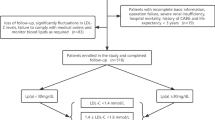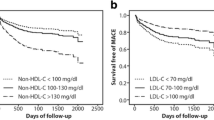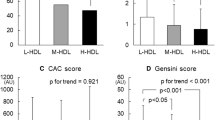Abstract
It is not yet clear whether the discordance of low-density lipoprotein cholesterol (LDL-C) and non-high-density lipoprotein cholesterol (non-HDL-C) predicts the follow-up clinical outcome (major adverse cardiovascular events: MACEs) in patients with coronary stent implantation. Among 2015 patients with coronary stent implantation (Fukuoka University [FU]-Registry), excluding those with acute coronary syndrome or hemodialysis, we selected 801 patients who had undergone successful stent implantation with a follow-up until 18 months, and classified them into 3 groups according to baseline LDL-C and non-HDL-C levels [percentile(P)non-HDL-C more than (P)LDL-C, (P)non-HDL-C equal to (P)LDL-C, and (P)non-HDL-C less than (P) LDL-C]. We found that the discordance of (P)LDL-C and (P)non-HDL-C was not a significant predictor of MACEs. Higher LDL-C level was consistently and independently associated with higher incidences of MACEs after controlling for conventional risk factors and the type of stent used by multivariate Cox regression analyses. In conclusion, LDL-C levels are more important than non-HDL-C levels and the discordance of LDL-C and non-HDL-C levels as predictors of MACEs in patients with stable angina after stent implantation.




Similar content being viewed by others
Change history
19 February 2018
Unfortunately, the Fig. 1 was published incorrectly in the original publication of the article. The correct figure is as below.
19 February 2018
Unfortunately, the Fig.?1 was published incorrectly in the original publication of the article. The correct figure is as below.
19 February 2018
Unfortunately, the Fig.?1 was published incorrectly in the original publication of the article. The correct figure is as below.
References
Nakamura H, Arakawa K, Itakura H, Kitabatake A, Goto Y, Toyota T, Nakaya N, Nishimoto S, Muranaka M, Yamamoto A, Mizuno K, Ohashi Y (2006) Primary prevention of cardiovascular disease with pravastatin in Japan (MEGA Study): a prospective randomised controlled trial. Lancet 368:1155–1163
Ridker PM, Danielson E, Fonseca FA, Genest J, Gotto AM, Jr., Kastelein JJ, Koenig W, Libby P, Lorenzatti AJ, MacFadyen JG, Nordestgaard BG, Shepherd J, Willerson JT, Glynn RJ, Group JS (2008) Rosuvastatin to prevent vascular events in men and women with elevated C-reactive protein. N Engl J Med 359:2195–2207
LaRosa JC, Grundy SM, Waters DD, Shear C, Barter P, Fruchart JC, Gotto AM, Greten H, Kastelein JJ, Shepherd J, Wenger NK, Treating to New Targets I (2005) Intensive lipid lowering with atorvastatin in patients with stable coronary disease. N Engl J Med 352:1425–1435
Pedersen TR, Faergeman O, Kastelein JJ, Olsson AG, Tikkanen MJ, Holme I, Larsen ML, Bendiksen FS, Lindahl C, Szarek M, Tsai J, and Incremental Decrease in End Points Through Aggressive Lipid Lowering Study G (2005) High-dose atorvastatin vs usual-dose simvastatin for secondary prevention after myocardial infarction: the IDEAL study: a randomized controlled trial. JAMA 294:2437–2445
Cannon CP, Braunwald E, McCabe CH, Rader DJ, Rouleau JL, Belder R, Joyal SV, Hill KA, Pfeffer MA, Skene AM, Pravastatin or Atorvastatin E, and Infection Therapy-Thrombolysis in Myocardial Infarction I (2004) Intensive versus moderate lipid lowering with statins after acute coronary syndromes. N Engl J Med 350:1495–1504
Kastelein JJ, van der Steeg WA, Holme I, Gaffney M, Cater NB, Barter P, Deedwania P, Olsson AG, Boekholdt SM, Demicco DA, Szarek M, LaRosa JC, Pedersen TR, Grundy SM, Group TNTS, Group IS (2008) Lipids, apolipoproteins, and their ratios in relation to cardiovascular events with statin treatment. Circulation 117:3002–3009
National Cholesterol Education Program Expert Panel on Detection E, Treatment of High Blood Cholesterol in A (2002) Third Report of the National Cholesterol Education Program (NCEP) expert panel on detection, evaluation, and treatment of high blood cholesterol in adults (Adult Treatment Panel III) final report. Circulation 106:3143–3421
Catapano AL, Reiner Z, De Backer G, Graham I, Taskinen, Wiklund O, Agewall S, Alegria E, Chapman M, Durrington P, Erdine S, Halcox J, Hobbs R, Hobbs R, Kjekshus J, Filardi PP, Riccardi G, Storey RF, Wood D, European Society of C, and European Atherosclerosis S (2011) ESC/EAS Guidelines for the management of dyslipidaemias The Task Force for the management of dyslipidaemias of the European Society of Cardiology (ESC) and the European Atherosclerosis Society (EAS). Atherosclerosis 217:3
Japan Atherosclerosis Society (JAS) Guidelines for Prevention of Atherosclerotic Cardiovascular Diseases 2017
Sniderman AD, Lamarche B, Contois JH, de Graaf J (2014) Discordance analysis and the Gordian Knot of LDL and non-HDL cholesterol versus apoB. Curr Opin Lipidol 25:461–467
Sniderman AD, Williams K, Contois JH, Monroe HM, McQueen MJ, de Graaf J, Furberg CD (2011) A meta-analysis of low-density lipoprotein cholesterol, non-high-density lipoprotein cholesterol, and apolipoprotein B as markers of cardiovascular risk. Circ Cardiovasc Qual Outcomes 4:337–345
Cui Y, Blumenthal RS, Flaws JA, Whiteman MK, Langenberg P, Bachorik PS, Bush TL (2001) Non-high-density lipoprotein cholesterol level as a predictor of cardiovascular disease mortality. Arch Intern Med 161:1413–1419
Sniderman AD, Islam S, Yusuf S, McQueen MJ (2013) Is the superiority of apoB over non-HDL-C as a marker of cardiovascular risk in the INTERHEART study due to confounding by related variables? J Clin Lipidol 7:626–631
Mora S, Buring JE, Ridker PM (2014) Discordance of low-density lipoprotein (LDL) cholesterol with alternative LDL-related measures and future coronary events. Circulation 129:553–561
Ike A, Shirai K, Nishikawa H, Iwata A, Yahiro E, Sugihara M, Kawamura A, Uehara Y, Zhang B, Ogawa M, Mori K, Miura S, Saku K (2015) Associations between different types of hypoglycemic agents and the clinical outcome of percutaneous coronary intervention in diabetic patients-from the FU-Registry. J Cardiol 65:390–396
Ike A, Nishikawa H, Shirai K, Mori K, Kuwano T, Fukuda Y, Takamiya Y, Yanagi D, Kubota K, Tsuchiya Y, Zhang B, Miura S, Saku K (2011) Impact of glycemic control on the clinical outcome in diabetic patients with percutaneous coronary intervention—from the FU-registry. Circ J 75:791–799
Nagata I, Ike A, Nishikawa H, Zhang B, Sugihara M, Mori K, Iwata A, Kawamura A, Shirai K, Uehara Y, Ogawa M, Miura S, Saku K (2015) Associations between lipid profiles and MACE in hemodialysis patients with percutaneous coronary intervention: from the FU-Registry. J Cardiol 65:105–111
Japanese Circulation Society (2011) Guidelines for Secondary Prevention of Myocardial Infarction (JCS 2011) http://www.j-circ.or.jp/guideline/pdf/JCS2011_ogawah_h.pdf. Accessed 5 Jan 2013
Sniderman AD, Islam S, Yusuf S, McQueen MJ (2012) Discordance analysis of apolipoprotein B and non-high density lipoprotein cholesterol as markers of cardiovascular risk in the INTERHEART study. Atherosclerosis 225:444–449
Otvos JD, Mora S, Shalaurova I, Greenland P, Mackey RH, Goff DC Jr (2011) Clinical implications of discordance between low-density lipoprotein cholesterol and particle number. J Clin Lipidol 5:105–113
Westfall PH, Tobias RD, Wolfinger RD (2011) Multiple Comparisons and Multiple Tests Using SAS, 2nd edn. SAS Institute Inc., Cary, pp 273–289
Allison PD (2010) Survival analysis using SAS. A practical guide, 2nd edn. SAS Institute Inc., Cary, pp 204–233
Matange S, Heath D (2011) Statistical graphics procedures by example: effective graphs using SAS, 2nd edn. SAS Institute Inc., Cary, pp 61–88
Stone NJ, Robinson JG, Lichtenstein AH, Bairey Merz CN, Blum CB, Eckel RH, Goldberg AC, Gordon D, Levy D, Lloyd-Jones DM, McBride P, Schwartz JS, Shero ST, Smith SC Jr, Watson K, Wilson PW, American College of Cardiology/American Heart Association Task Force on Practice G (2014) 2013 ACC/AHA guideline on the treatment of blood cholesterol to reduce atherosclerotic cardiovascular risk in adults: a report of the American College of Cardiology/American Heart Association Task Force on Practice Guidelines. J Am Coll Cardiol 63:2889–2934
Sniderman A, McQueen M, Contois J, Williams K, Furberg CD (2010) Why is non-high-density lipoprotein cholesterol a better marker of the risk of vascular disease than low-density lipoprotein cholesterol? J Clin Lipidol 4:152–155
Lawler PR, Akinkuolie AO, Ridker PM, Sniderman AD, Buring JE, Glynn RJ, Chasman DI, Mora S (2017) Discordance between circulating atherogenic cholesterol mass and lipoprotein particle concentration in relation to future coronary events in women. Clin Chem 63:870–879
Saku K, Zhang B, Noda K, Investigators PT (2011) Randomized head-to-head comparison of pitavastatin, atorvastatin, and rosuvastatin for safety and efficacy (quantity and quality of LDL): the PATROL trial. Circ J 75:1493–1505
Zhang B, Matsunaga A, Rainwater DL, Miura S, Noda K, Nishikawa H, Uehara Y, Shirai K, Ogawa M, Saku K (2009) Effects of rosuvastatin on electronegative LDL as characterized by capillary isotachophoresis: the ROSARY Study. J Lipid Res 50:1832–1841
Zhang B, Miura S, Yanagi D, Noda K, Nishikawa H, Matsunaga A, Shirai K, Iwata A, Yoshinaga K, Adachi H, Imaizumi T, Saku K (2008) Reduction of charge-modified LDL by statin therapy in patients with CHD or CHD risk factors and elevated LDL-C levels: the SPECIAL Study. Atherosclerosis 201:353–359
Zhang B, Katafuchi R, Arishima H, Matsunaga A, Rye KA, Saku K (2006) Effects of atorvastatin and apoA-I/phosphatidylcholine discs on triglyceride-rich lipoprotein subfractions as characterized by capillary isotachophoresis. Clin Chim Acta 373:55–61
Author information
Authors and Affiliations
Corresponding authors
Ethics declarations
Disclosures
Research and education grants, and payments for consulting and promotional speaking (KeS) were received from MSD Co., SANOFI, Takeda Pharmaceutical Co., Ltd., Bayer, Eli Lilly, Co. (clinical research grant), and TOA EIYO Co. KeS and MS are Directors of NPO Clinical and Applied Science, Fukuoka, Japan. KaS, SM, and KeS had received a grant from the Public Interest Incorporated Foundation of “Clinical Research Promotion Foundation” in Fukuoka, Japan, and part of this work was transferred to NPO Clinical and Applied Science, Fukuoka, Japan. KeS has an Endowed Department of Molecular Cardiovascular Therapeutics (YU, SM), Fukuoka University, supported by MSD Co., Ltd, and an Endowed Department of Community and Emergency Medicine (HN, MS), Fukuoka University, supported by Izumi City, Kagoshima, Japan.
Electronic supplementary material
Below is the link to the electronic supplementary material.
Rights and permissions
About this article
Cite this article
Shiiba, M., Zhang, B., Miura, Si. et al. Association between discordance of LDL-C and non-HDL-C and clinical outcomes in patients with stent implantation: from the FU-Registry. Heart Vessels 33, 102–112 (2018). https://doi.org/10.1007/s00380-017-1036-x
Received:
Accepted:
Published:
Issue Date:
DOI: https://doi.org/10.1007/s00380-017-1036-x




